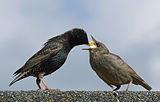- Oophagy
-
Oophagy (pronounced /oʊˈɒfədʒi/ oh-off-ə-jee), literally "egg eating", is the practice of embryos feeding on eggs produced by the ovary while still inside the mother's uterus. The word oophagy is formed from the classical Greek ᾠόν (ōion, egg) and classical Greek φᾱγεῖν (phāgein, to eat).
Oophagy is thought to occur in all sharks in the order Lamniformes and has been recorded in the bigeye thresher (Alopias superciliosus), the pelagic thresher (A. pelagicus), the shortfin mako (Isurus oxyrinchus) and the porbeagle (Lamna nasus) among others.[1] It also occurs in the tawny nurse shark (Nebrius ferrugineus), and in the family Pseudotriakidae.
This practice may lead to larger embryos or prepare it for a predatory lifestyle.[2]
There are variations in the extent of oophagy among the different shark species. The grey nurse shark (Carcharias taurus) practices intrauterine cannibalism, the first developed embryo consuming both additional eggs and any other developing embryos. Slender smooth-hounds (Gollum attenuatus), form egg capsules which contain 30-80 ova within which only one ovum develops while all other ova are ingested and packed to an external yolk sac. The embryo then develops normally without ingesting further eggs.[1]
Oophagy is also used to refer to more general egg-eating behaviours such as those practised by some snakes or the differential oophagy practiced by the Polistes biglumis species of wasp.
Ovophagy
Ovophagy is a rare though widely observed condition in the reproduction of certain animals, whereby fetuses will devour each other prior to birth. Subsequent research has shown ovophagy to be sporadic and highly uncommon among the vast majority of animal species.
Notes
- ^ a b Christina L. Conrath. "Elasmobranch Fisheries Management Techniques Chapter 7". http://www.flmnh.ufl.edu/fish/organizations/ssg/EFMT/7.pdf. Retrieved 3 August 2006.
- ^ Wourms, J. P. (1981) Viviparity: The maternal-fetal relationship in fishes. Am. Zool. 21:473-515.
Feeding behaviours Carnivores adultHematophagy · Insectivore · Lepidophagy · Man-eater · Molluscivore · Mucophagy · Myrmecophagy · Ophiophagy · Piscivore · Avivore · Spongivore · Vermivore · Herpetivorereproductivecannibalistic
Herbivores Others Methods Apex predator · Bait balls · Bottom feeding · Browsing · Feeding frenzy · Filter feeding · Grazing · Hypercarnivore • Intraguild predation · Kleptoparasitism · Scavenging · TrophallaxisPredation · Antipredator adaptation · Carnivorous plant · Carnivorous fungus · Carnivorous protist · Category:Eating behaviors Categories:- Sharks
- Carnivory
- Biology terminology
Wikimedia Foundation. 2010.
